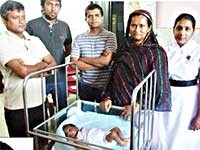With poor nutrition carrying a significant economic burden for individuals and for the country’s economy, the cost of malnutrition in terms of healthcare impact can be staggering.
According to an 2024 Institute of Policy Studies (IPS) analysis, in the aftermath of the recent crises, nutrition and its related health problems have become major concerns for Sri Lanka.
The prevailing high volatility of food prices is an added concern, as heightened uncertainty can compromise sustainable and long-term consumption decisions of households, prolonging the situation of inadequate food intake. The rise in food prices and income losses have therefore significantly constrained the population’s ability to afford a nutritious diet.
As per the ‘Household Survey on Impact of Economic Crisis – 2023’ of the Department of Census and Statistics (DCS), over 90% of households experienced increased monthly expenditures, with food inflation being the primary cause. Moreover, the prevalence of stunting, wasting, and underweight children under five years of age has increased post-pandemic, highlighting long-term health issues.
Malnutrition also generates new and significant costs that both health systems and their users will bear in future, since being undernourished makes people more vulnerable to preventable infections and diseases, leading to increased spending on healthcare and treatment.
Changing consumption patterns
Outlining the nutritional profile of an average Sri Lankan meal at present, Nutrition Society of Sri Lanka President and Wayamba University Department of Applied Nutrition Professor Ananda Chandrasekara pointed out that most Sri Lankans consumed a rice-and-curry-based diet.
He added that in general, even before the crisis, consumption was mainly focused on a lot of carbohydrates, a certain amount of animal protein and plant protein, and a small amount of vegetables and fruits.
Following the economic crisis, there have been significant impacts on food consumption, especially with the price increase in protein sources such as eggs and fish.
The IPS’s ‘Sri Lanka: State of the Economy 2024’ report found that protein sources such as meat, fish, and eggs have become prohibitively expensive for many families, leading to households employing various coping strategies to manage their limited resources.
These include reducing the number of meals per day, limiting adults’ consumption of food in order to ensure children have enough to eat, and skipping meals altogether, highlighting how economic hardships have pushed families towards a more calorie-centric diet at the expense of macro and micronutrient intake.
Similarly, as Prof. Chandrasekara noted, when prices rise, people’s consumption behaviour changes. Accordingly, while calories or energy can be obtained from carbohydrates, proteins, and fats, the cheapest source of energy is carbohydrate while protein is more expensive. Therefore, when people are financially constrained, their purchasing and dietary behaviour changes, opting to fill the stomach rather than focusing on quality.
“As a result, they opt for low-quality energy sources like carbohydrates such as rice, wheat flour, or sugar, instead of opting for more expensive calories like protein sources – animal protein sources or even plant protein,” he said.
Moreover, he noted that with the increase in prices of fruits and vegetables, given limited incomes, fruit and vegetable consumption was no longer a priority, leading people to minimise the consumption of these food items further, which was problematic in a context where their consumption was already low.
Triple burden of malnutrition
As a result of such changes in consumption behaviour, observable health issues have emerged, especially in children and low-income adults. According to Prof. Chandrasekara, while starvation is not that common at present, obesity has become the main concern, since people spend on low-quality calorie food items.
“When you buy a lot of low-quality calorie items and fill the stomach instead of going for a balanced meal, you are consuming an additional amount of calories. Further, physical inactivity is a major problem at present,” he said.
He further noted that this was a problem that lower income earners were more vulnerable to, since they tended to purchase low-quality calorie food items and opted for high-carbohydrate or high-energy diets rather than quality food needed for a balanced diet, which impacted the emergence of obesity in underprivileged communities.
“This is a triple burden of malnutrition: undernutrition (stunting, underweight), overnutrition (obesity and associated conditions), and hidden hunger (micronutrient deficiency – i.e. iron deficiency, vitamin deficiency, etc.),” he added.
In the long term, there is a significant developmental impact of this chronic malnutrition in children. Prof. Chandrasekara noted: “Chronic malnutrition in young children causes the body to become a breeding ground for Non-Communicable Diseases (NCDs) as adults, such as cardiovascular disease, diabetes, hypertension, and even cancer.”
A pressing local and global issue
Poor nutrition remains a pressing issue in post-crisis Sri Lanka, as well as globally. A 2024 study titled ‘The cost of inaction: A global tool to inform nutrition policy and investment decisions on global nutrition targets’ in Health and Policy Planning notes that the world is off course to meet most of the global nutrition targets set to be achieved by 2025 by the World Health Assembly (WHA) in 2012.
The study notes that malnutrition is responsible for more ill health than any other issue, and the treatment costs are borne by individuals and families as well as public sector health and insurance systems, with expensive treatment costs pushing poor families further into poverty.
Further, suboptimal physical growth causes life-long susceptibility to illnesses, which leads to lower labour productivity and absenteeism from work, and results in lower lifetime earnings. Poor nutrition during early childhood and adolescence impairs cognitive development, hinders school attendance, and reduces attainment, resulting in lost employment opportunities.
According to the United Nations Children’s Fund (UNICEF), children who are undernourished “achieve less in school” and “are paid less when they enter the workforce”.
Moreover, poorly nourished children tend to enrol in school later than other children. They also tend to progress more slowly across grades, have lower levels of scholarly achievement, perform poorly on cognitive achievement tests, and carry these deficits into adulthood.
Health Ministry measures
Meanwhile, Ministry of Health Nutrition Division Director Dr. Monika Wijeratne told The Sunday Morning that the food safety hub under Health Ministry Secretary Dr. Anil Jasinghe, which operated at the presidential level, dealt with matters involving public nutrition and how to provide a diet of healthy food to the public.
One of the concerns being addressed under this includes dietary behaviour. “What we need to do is change the food behaviour or culture of people, since it is not solely that food is expensive, but that people have become accustomed to fast food/ultra-processed food due to convenience and accessibility.”
In terms of national policy, she pointed to the Food-Based Dietary Guidelines, which recommends the kind of dietary patterns people should follow, as well as other policy positions such as the National Nutrition Policy. She added that all these guidelines had been formulated for various age categories to recommend appropriate diets, as well as what to consume when afflicted with various nutritional deficiencies.
“Given the marketing for ultra-processed food, these guidelines haven’t reached the grassroots level yet. Due to this, the Health Ministry prepared a Cabinet paper recently on how to promote healthy food behaviour among the public and on public food safety.
“In terms of healthy food, the Health Ministry can only issue guidelines, since it cannot increase food availability. This must be done by the Ministries of Agriculture, Fisheries, etc. and requires multi-sectoral involvement of stakeholders. The Cabinet paper has prepared an activity plan on how to involve all these stakeholders and undertake this process,” she said.
Dr. Wijeratne further noted that given the scattered nature of data regarding people’s nutrition, another significant requirement was to formulate a surveillance system. An activity plan has also been made for this.
With this year’s National Nutrition Month being held under the theme of ‘Vegetables and Fruits: Always Keep You Healthy,’ the Nutrition Division Director said that it was intended to promote increased consumption of fruits and vegetables while minimising the consumption of ultra-processed foods.
This programme intends to be a solution to the perception that fruits and vegetables are expensive, promoting the consumption of locally available produce instead.
Further, steps are also being taken to address the nutritional behaviour of children. Dr. Wijeratne said: “Transforming the dietary patterns of schoolchildren is a long-lasting approach, since their food culture is what continues into adulthood.
“At present, we are seeing a tendency towards NCDs among schoolchildren, with an increase in obesity and overweight conditions. Therefore, as a solution to this, we are formulating a policy framework to enable the availability of healthy fruit and vegetable-based food in school canteens and around schools, in collaboration with the Ministry of Education.”
Source: TheMorning
© All images and text content are credited to their respective owners.

















